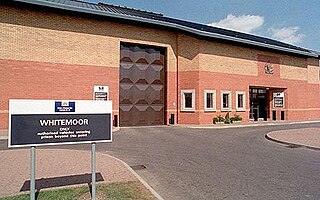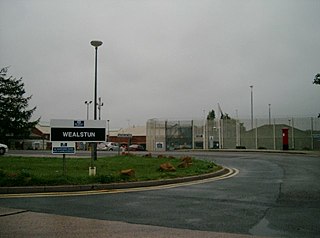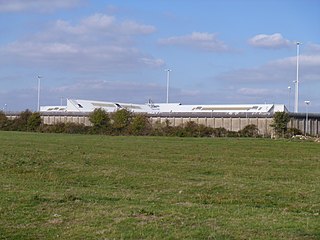Related Research Articles

His Majesty's Prison Service (HMPS) is a part of HM Prison and Probation Service, which is the part of His Majesty's Government charged with managing most of the prisons within England and Wales.

HM Prison Whitemoor is a Category A men's prison near March, Cambridgeshire, England, operated by His Majesty's Prison Service.

His Majesty's Prison Belmarsh is a Category A men's prison in Thamesmead, southeast London, England. The prison is used for high-profile cases, particularly those concerning national security. Within the grounds is the High Security Unit (HSU), which consists of 48 single cells. It is run by His Majesty's Prison Service. The prison has been called "Britain's Guantanamo Bay" due to the long-term detention of terrorism suspects without charge. Considered the toughest prison in the UK, Belmarsh is also notoriously known as "Hellmarsh" due to the high number of physical and authority abuses reported by both the prison's inmates, and by human rights activists.

Forest Bank Prison is a Category B men's private prison, in the Agecroft area of Pendlebury in Salford, England. The prison is currently operated by Sodexo Justice Services.
HMP & YOI Prison Brinsford is an adult male Category B & C prison and Young Offenders Institution (YOI), located in the village of Featherstone, in Staffordshire, England. The prison is operated by His Majesty's Prison Service.

HM Prison Frankland is a Category A men's prison located in the village of Brasside in County Durham, England. Frankland is operated by His Majesty's Prison Service, and is located next to HM Prison Low Newton, a closed women's prison.

HM Prison Woodhill is a Category B men's high security prison located in Milton Keynes, England. The prison is operated by His Majesty's Prison Service. A section of the prison is designated as a Young Offenders Institution. A Secure Training Centre is located next to the prison.
HM Prison Albany is a Category B men's prison, situated on the outskirts of Newport on the Isle of Wight, England. The prison is operated by His Majesty's Prison Service. Albany is located next to Parkhurst, another Male/B prison and together they form HM Prison Isle of Wight.

HM Prison Wealstun is a Category C men's prison, located near the village of Thorp Arch in West Yorkshire, England. The prison is operated by His Majesty's Prison Service.

HM Prison Long Lartin is a Category A men's prison, located in the village of South Littleton in the Wychavon district in Worcestershire, England. It is operated by His Majesty's Prison Service.

HM Prison Winchester is a Category B men's prison, located in Winchester, Hampshire, England. The prison is operated by His Majesty's Prison Service.
HM Prison Whatton is a Category C men's prison, located in the village of Whatton, near Bingham in Nottinghamshire, England. The prison is operated by His Majesty's Prison Service, and houses males convicted of sexual offences.

HM Prison and Young Offenders Institute Bullingdon is a prison in Oxfordshire, England. It is a public sector prison operated by HM Prison and Probation Service.

HM Prison Erlestoke is a Category C men's prison, to the east of the village of Erlestoke in Wiltshire, England. Erlestoke is operated by His Majesty's Prison Service, and is the only prison in Wiltshire.
HM Prison Lowdham Grange is a Category B men's [prison], located in the village of Lowdham in Nottinghamshire, England. Since 1st August 2024, the prison has been operated by HM Prison Service (HMPPS)

HM Prison Risley is a category C men's prison, located in the Risley area of Warrington, Cheshire, England, operated by His Majesty's Prison Service.

HM Prison Swaleside is a Category B men's prison, located close to the village of Eastchurch on the Isle of Sheppey, Kent. Swaleside forms part of the Sheppey prison cluster, which also includes HMP Elmley and HMP Standford Hill. The prison is operated by His Majesty's Prison Service.
HM Prison Hewell is a multiple security category men's prison in the village of Tardebigge in Worcestershire, England. The prison is operated by His Majesty's Prison Service.

HM Prison Humber is a Category C men's prison, located south-west of Everthorpe, in the East Riding of Yorkshire, England. The prison is operated by His Majesty's Prison Service, and was created from the 2014 merger of two neighbouring prisons: HMP Everthorpe and HM Prison Wolds.
References
- 1 2 Travis, Alan (13 February 2016). "UK government considers single secure jail unit for Islamist terrorists". The Guardian. Retrieved 2 October 2017.
- ↑ "George Blake (Escape from Prison): 24 Oct 1966: House of Commons debates - TheyWorkForYou". theyworkforyou.com. Retrieved 2 October 2017.
- ↑ Joyce, Peter (2013). Criminal justice : an introduction (2 ed.). New York: Routledge. p. 302. ISBN 9780415620628.
- ↑ Cuneen, Chris; Anthony, Thalia, eds. (2008). The critical criminology companion. Leichhardt, N.S.W.: Hawkins Press. p. 244. ISBN 9781876067236.
- ↑ Davies, Michael; Croall, Hazel; Tyrer, Jane (2009). "13: Prisons". Criminal Justice (4 ed.). New York: Pearson Longman. p. 439. ISBN 978-1-4058-5880-9.
- ↑ Woodcock 1994, p. 9.
- ↑ "High security". www.justice.gov.uk. Retrieved 3 October 2017.
- ↑ "Improvements at murder-hit prison". BBC News. 30 April 2013. Retrieved 3 October 2017.
- ↑ Travis, Alan (13 January 2009). "Gang culture flourishing in top-security jail Long Lartin, report by chief inspector of prisons reveals". The Guardian. Retrieved 3 October 2017.
- ↑ Smith, Hayden (25 July 2017). "High-security prisoners 'segregated for up to two years', report finds". The Independent. Retrieved 3 October 2017.
- ↑ Travis, Alan (3 March 2008). "Officials warn of terrorist links to prison gangs". The Guardian. Retrieved 3 October 2017.
- ↑ Flynn, Nick (1998). "3: Prisons". Introduction to prisons and imprisonment. Winchester: Waterside Press. p. 51. ISBN 1-872-870-37-6.
- ↑ Hughes, Mark (23 March 2010). "HMP Frankland's brutal regime – the inside story". The Independent. Retrieved 2 October 2017.
- ↑ "Isle of Wight Prison information". Ministry of Justice. Retrieved 3 October 2017.
- ↑ "Report of an unannounced inspection of HMP Belmarsh". HM Inspectorate of Prisons. May 2015. p. 29. Archived from the original (PDF) on 4 August 2016. Retrieved 3 October 2017.
- ↑ Smith, Noel 'Razor' (2015). The criminal alphabet: an A–Z of prison slang (1 ed.). London: Penguin Books. p. 47. ISBN 9780141038568.
- ↑ Clarke, Peter (June 2016). "Report of an unannounced inspection of HMP Frankland". HM Inspectorate of Prisons. pp. 5–7. Archived from the original (PDF) on 4 August 2016. Retrieved 2 October 2017.
- ↑ "Report on an unannounced inspection of HMP Full Sutton". HM Inspectorate of Prisons. May 2016. p. 7. Archived from the original (PDF) on 3 December 2022. Retrieved 3 October 2017.
- ↑ "Life behind bars, a prison officer's tale". Harborough Mail. 19 March 2013. Retrieved 2 October 2017.
- ↑ "Gartree Prison". Ministry of Justice. Retrieved 3 October 2017.
- ↑ "Hull Prison information". Ministry of Justice. Retrieved 2 October 2017.
- ↑ "HMP Long Lartin" (PDF). HM Inspectorate of Prisons. March 2015. p. 7. Retrieved 3 October 2017.
- ↑ Cusick, James (10 January 1995). "The Parkhirst[sic] Breakout: Fugitives were trapped by the sea". The Independent. Retrieved 2 October 2017.
- ↑ "Eight of the most audacious prison escapes ever". The Telegraph. 27 July 2017. Retrieved 2 October 2017.
- ↑ "Wakefield Prison information". Ministry of Justice. Retrieved 2 October 2017.
- ↑ Woodcock 1994, p. 10.
- ↑ Smith, Noel (29 September 2017). "Behind the gate". insidetime. Retrieved 3 October 2017.
Sources
- Woodcock, John (1994). Report of the enquiry of the escape of six prisoners from the special security unit at Whitemoor Prison, Cambridgeshire on 9th September 1994 (PDF) (Report). London: The Home Office.